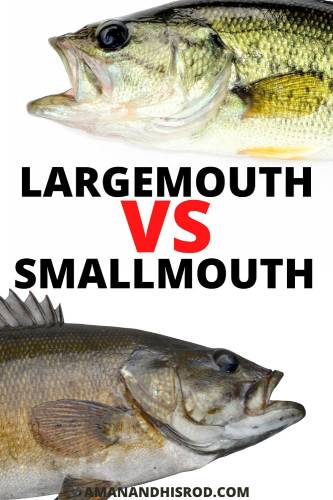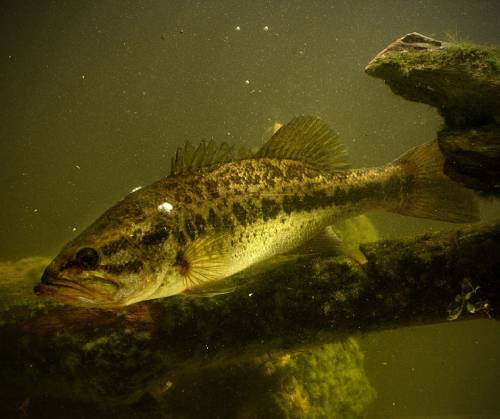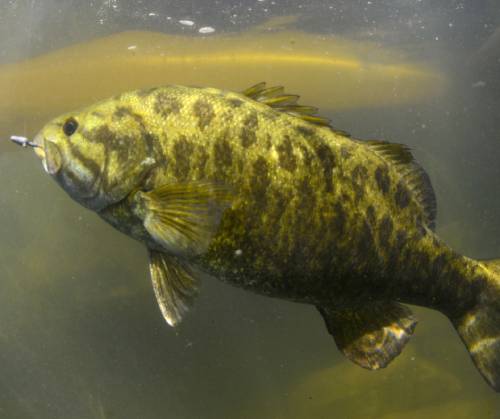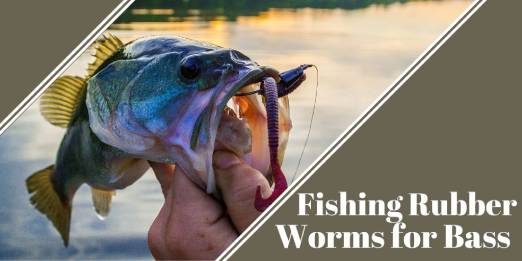What’s the difference between smallmouth vs. largemouth bass? We’ll get into that in a second, but first, here’s a little information about the bass fishing industry.
Smallmouth and largemouth bass are two of the most popular sport fish in North America. The fishing industry around these two species today generates around 60 billion dollars a year, that’s a lot of fishing equipment.
The bass fishing industry’s total economic income due to output and indirect contributions tallies up to around 115 billion dollars in total, With countless tournaments a year and an extremely large number of companies big and small dedicated to these two species.
Let’s get into the differences between smallmouth vs largemouth bass.
This website is reader supported. Any purchases you make through links on this site earn us a commission at no additional cost to you. Thank you for your support!
Anatomy and Physiology of Smallmouth vs Largemouth Bass
There are some key differences in these two bass species but they may have more in common than you think. Diet is one thing that these two fish have in common. They often feed on the same things but with very different temperaments.
Here are some of the key differences between smallmouth vs. largemouth bass.
Smallmouth Bass
Smallmouth bass are typically brown, but can sometimes appear almost black, with red or brown eyes and dark brown bands running vertically along the side of its body.
The coloration and hues may vary depending on the habitat in which they live, as well as the forage and diet they feed on in a given body of water. Smallmouth bass also have darker vertical lines on their body.

Smallmouth bass have 12 to 13 soft rays on their top dorsal fin and an upper jaw that extends to the middle of the eye.
Hence their name, smallmouth bass have smaller mouths compared to their green counterparts and don’t grow as large as largemouth bass, topping out at around 10 pounds.
Smallmouth bass will have a shorter jaw than largemouth.
Largemouth Bass
1. The Colorations of the largemouth bass range from olive green to grayish green and their sides are marked with dark blotches, on some fish these can be black in color. These patterns tend to be more horizontal rather than vertical like the smallmouth.
These markings typically create a broken and jagged line that runs horizontally along the side of the fish from its head to its tail.
Largemouth bass grow larger than smallmouth bass, and can reach up to 15 pounds or more, with a maximum unofficial weight of up to 25 pounds!
- Largemouth bass have a much wider mouth compared to Smallmouth bass, hence their name.
- Another key difference is in the dorsal fin. On a largemouth bass, the dorsal fins are separated. The smallmouth bass will look like one continuous dorsal fin.
- The Last thing I will point out is the length of the mouth. A largemouth bass’s mouth will extend past the eye of the fish.


Habitats of Smallmouth vs. Largemouth Bass
The habitat of smallmouth vs largemouth bass is maybe the biggest difference between the two. Pay close attention to the type of water that I talk about in these next two sections.
Smallmouth Bass
The waters in which smallmouth bass inhabit are generally higher in clarity when compared to largemouth bass. The fish has a preference for clear water streams, lakes, rivers, and reservoirs with rocky areas, stumps, and sandy bottoms.
Along with clear water, the fish also live in lakes that are capable of sustaining cooler water temperatures. Due to intolerance to pollution, a healthy smallmouth population is a good indicator that the waters they inhabit are clean and healthy.
They prefer current more than largemouth bass as well and can be found in fast moving rivers, and there is actually a difference between river fish and lake fish, with river fish maintaining a more torpedo shaped body, while lake smallmouth typically has a more oval shape.
Largemouth Bass

Largemouth bass can inhabit a much wider range of habitats compared to smallmouth bass and this is the reason why largemouth bass can be found almost anywhere in the continental United States where there is a large enough body of water.
From ponds, creeks, reservoirs, flowages, swamps, backwaters, pools, lakes, and everywhere in between.
Largemouth bass can tolerate warmer water temperatures better than smallmouth bass and are keen to use very thick and shallow vegetation for cover.
Distribution of Bass
Smallmouth Bass
Smallmouth bass are native to the upper Mississippi region, the St. Lawrence River, and the Great Lakes Region. Along with these areas, the Smallmouth bass can be found spread throughout the Northern and Western regions of the United States and Canada.
Artificial stocking has increased the range of the smallmouth bass, and can now be found farther south, and west, than their native ranges in a variety of suitable habitats such as reservoirs.
Largemouth Bass
Largemouth bass can be found almost anywhere in the United States where there’s water, with few exceptions.
Chances are, there’s a body of water very near to you that largemouth bass inhabits. Along with being found in every state in the continental U.S., the largemouth bass can also be found in the northern regions of Mexico and the southern reaches of Canada.
The Largemouth has also been planted in other areas of the world like Japan, Europe, Central America, and more.
In some regions of the globe Largemouth bass has become an invasive species, Guatemala the largemouth has been blamed and responsible for the extinction of a localized endemic bird, the Atitlan Grebe, whose home range was Lake Atitlan, by decimating the young of the year birds, feeding on them, and creating a situation that the Grebe was unable to rebound from.
Feeding Habits of Smallmouth vs. Largemouth Bass
Let’s break down some of the key feeding habits in regard to smallmouth vs. largemouth bass. These habits are important to understand in order to present the right lures to these fish.
Smallmouth Bass
Smallmouth bass actually have different feeding habits at times when compared to Largemouth bass. While both species feed on essentially the same prey.
Smallmouth bass doesn’t rely on cover when feeding. This is more true in the summer months when schools of baitfish are inhabiting deep open water as the water temperatures climb.
Smallmouth bass will leave the sanctuary of cover to live in the open water and travel long distances with no cover. This is more so the case if the main forage bass for smallmouth bass in a particular body of water is not based around crayfish.
Largemouth Bass
Largemouth are cover oriented fish, whether they are feeding or not. But cover is essential in terms of feeding and is the main reason why they are fairly easy to target by anglers, they are predictable in their locations. Largemouth bass use cover to ambush prey, hiding in thick vegetation and stumps or underwater brush piles, using their colorations and patterns as camouflage to blend in and strike when prey is close and unaware.
Angling Tactics: Smallmouth vs Largemouth Bass

Smallmouth Bass
Targeting smallmouth bass is similar to largemouth bass in the spring when they are spawning, while their locations are different.
Smallmouth spawns in gravel or rock. During spawning smallmouth bass are extremely aggressive and will strike anything near their beds.
Some great methods for catching them at this time are using crayfish imitations, or jerkbaits worked with pauses or shallow gravel bars. I find that Texas rigging a soft plastic craw like the one pictured below provides enough of a threat to entice strikes.
Strike King Rage Tail

Features
- Available in 3″ or 4″
- Awesome Underwater Action
- Unique Claw Action
- Proven Results
During the summer and fall months, smallmouth bass can also be found roaming the basin after schools of baitfish. Fishing crankbaits and jerkbaits work great for this and are able to get to the depths required to get in the strike zone.
Texas Rigging and jigging are other very popular ways to catch smallmouth, drop shot rigs are great for getting down deeper and for precision fishing spots like deep rock piles. While jigging can be used at any depth.
Largemouth Bass
Largemouth bass can be caught using the same methods as smallmouth bass. But there are preferences in targeting smallmouth vs largemouth.
Due to their tendency to inhabit thick cover, presentations such as weedless skirted jigs, fishing soft plastics, spinnerbaits, and topwater are the most popular tactics to get a largemouth to bite.
Fishing beds in spring is a popular tactic for using soft plastics or jigs, and unlike smallmouth, you may have to work on one individual fish for an extended period of time to get it to react.
Crankbaits work great as well when targeting Largemouth bass on deeper structures like brush piles or cribs.
Popular Lures for Smallmouth vs. Largemouth Bass
There are not too many differences in lure selection for smallmouth vs largemouth bass. Here are some key lures to get started with.
Smallmouth Bass
While both species can be caught on virtually the same lures. We can still take a look at what some anglers prefer for each species.
For smallmouth fishing jigs are incredibly popular and work well at any depth, while not typically weedless, they are usually worked over rock and gravel where getting snagged on branches and weeds is less of an issue.

A jig head rigged wacky style with a Senko work is also a popular tactic for getting deeper in the water column and doing it quickly.
Another old although great method is fishing with spoons, spoons are excellent smallmouth lures and work great when using them in a method where you can jig and flutter them down, like a wounded baitfish.
With this in mind, just like Largemouth bass, lures like skirted jigs, spinnerbaits, and topwater work equally as well on smallmouth.
Largemouth Bass
The skirted jig along with Texas-rigged plastics are probably the most popular lures to target Largemouth bass with. Learning how to catch bass with plastics is critical.
Due to their weedless and snagless designs, you can punch them through heavy cover where Largemouth bass wait to ambush prey.
Below is a Texis Rig Kit to get you on your way to cathing bass. Just add your favorite soft plastic and your good to go!

Other good lures are spinnerbaits and topwater, again these lures have excellent designs for working around brush piles, timber, weeds, and stumps.
For deeper spots like cribs or rock piles, weed humps, and points, Crankbaits and deeper running jerkbaits can really shine.
RECOMMENDED ARTICLE >> BEST TOP WATER LURE FOR BASS
Conclusion – Smallmouth vs Largemouth Bass
Before we wrap this up, I would love for you to leave a comment at the bottom of this post and share to your favorite social platform. This helps me get more articles added to the website.
This isn’t an article trying to decide if smallmouth vs largemouth is better to fish for or to shine a light on not only the differences between these two species but also just how similar they are as well.
Largemouth bass will always be the more popular species due to their abundance around North America.
Smallmouth bass and the waters they inhabit are different in terms of habits, and location, and this changes the approach used by anglers to fish for them.
One thing to consider is that these fish also cohabitate, especially in the native northern realms where smallmouth are found and can provide anglers with excellent fishing and the chance to employ tactics for both fish on the same body of water.
Hopefully, this article taught you some interesting information, and will help you in your pursuit of either of these species, or even if you’re in the right location, both species!

